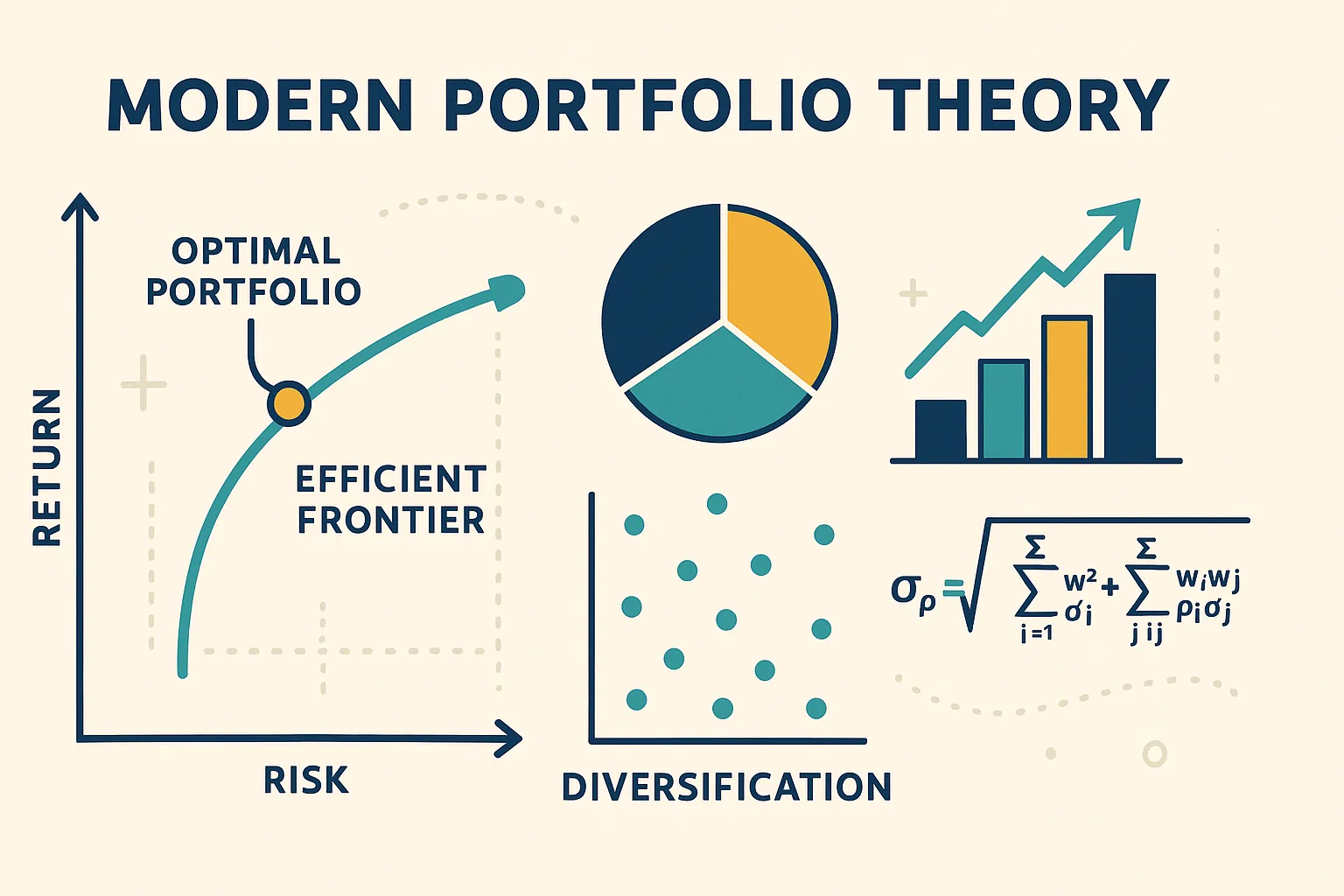Modern Portfolio Theory in practice

Let’s be honest—investing can feel overwhelming. With so many options and risks, how do you know if your portfolio is set up for success? That’s where Modern Portfolio Theory (MPT) comes in. Created by Harry Markowitz in 1952, MPT is all about finding the right balance between risk and reward through smart diversification.
It’s not just for Wall Street pros. You can use MPT to make better investment decisions, and we’ll show you exactly how—with clear examples and practical steps you can apply to your own portfolio. Plus, we’ll talk about where MPT falls short and how to work around its weaknesses.
Key Takeaways
- MPT helps you maximize returns for a given level of risk by diversifying wisely.
- The efficient frontier shows the best possible balance between risk and return.
- Asset correlation is key—mixing investments that don’t move together reduces risk.
- MPT isn’t perfect, especially during market crashes, so it’s important to stay flexible.
The Core Idea of Modern Portfolio Theory
MPT is basically a smarter way to follow the old advice: “Don’t put all your eggs in one basket.” But instead of just spreading your money around randomly, MPT helps you find the optimal mix of investments.
How It Works
- Diversification Lowers Risk – Instead of betting everything on one stock or sector, MPT encourages you to hold a mix of assets that don’t move in sync.
- The Efficient Frontier – This helps you find the best portfolios that give you the highest return for the risk you’re willing to take.
- Risk is Measured by Volatility – The more an asset’s price jumps around, the riskier it is.
- Expected Return is Based on Past Performance – MPT assumes that historical returns can help predict future performance.
A Simple Example of MPT in Action
Let’s say you have $100,000 to invest. You’re considering two options:
- Stock A: A tech company with high growth but also high volatility.
- Stock B: A utility company with steady but lower returns.
If you put 100% in Stock A, your portfolio could skyrocket—or crash. If you go 100% into Stock B, you get stability, but your growth might be too slow. MPT suggests combining both to smooth out the highs and lows.
Now, let’s add a third asset—government bonds, which tend to rise when stocks fall. By blending these three in a smart way (not just 33%-33%-33%), you create a portfolio with lower overall risk while still capturing growth.
This is MPT in action: balancing risk and reward through smart diversification.
The Efficient Frontier: Finding the Sweet Spot
MPT can be used to map out different portfolios on a graph, showing the best risk-return tradeoff. This curve is called the Efficient Frontier.
- Portfolios below the curve aren’t optimized—you’re taking too much risk for the return.
- Portfolios on the curve are ideal—offering the highest return for a given level of risk.
- Portfolios beyond the curve are impossible—they don’t exist in real-world markets.
The chart below illustrates this concept visually:

In the graph, the blue curve represents the Efficient Frontier, where portfolios are optimized to provide the best possible return for a given level of risk. The Capital Market Line (CML) highlights the optimal combination of risk-free assets and risky assets, guiding investors toward efficient portfolio choices. Any portfolio positioned below the frontier is considered inefficient, as it takes on excessive risk without adequate compensation in returns.
Your goal? Position your portfolio on or near the Efficient Frontier, ensuring that every bit of risk you take is justified by the potential return. While the theory provides a useful benchmark, real-world constraints like shifting correlations, liquidity, and behavioral biases mean investors should use the Efficient Frontier as a guideline rather than an absolute target.
How to Apply MPT to Your Own Portfolio
1. Assess Your Risk Tolerance
- If you’re comfortable with market swings, you might lean toward more stocks.
- If you prefer stability, you’ll want a mix that includes bonds and other low-risk assets.
2. Find a Universe of Potentially Diversified Investments
- Stocks (growth potential but higher risk)
- Bonds (stability and income)
- Commodities (inflation protection)
- Real estate (alternative asset for diversification)
3. Measure Correlation and Expected Returns
- To effectively diversify, you need to measure how different assets interact within your portfolio. Simply assuming that certain assets hedge against each other isn't enough—correlation should be quantified to make data-driven decisions.
Example: Instead of manually selecting assets, a portfolio optimizer (such as PortfolioPilot.com) can analyze thousands of possible portfolio combinations. By adjusting weightings, the optimizer helps identify the most efficient portfolio allocation—one that maximizes expected returns at your current risk preference.
4. Rebalance Regularly (Bonus)
- Some assets will grow faster than others, shifting your portfolio’s balance.
- Rebalancing keeps your risk level in check.
5. Run Stress Tests (Bonus)
- How would your investments perform in a market crash?
- Could you handle a 20% drop in value?
- Use historical data and scenario analysis to prepare for downturns.
The Downsides of Modern Portfolio Theory and Alternative Approaches
MPT is a fantastic tool, but it’s not perfect. In fact, it has failed in real-world scenarios—most notably during the 2008 financial crisis. The theory assumes that different asset classes will behave independently, but when panic hits the markets, correlations between assets tend to rise. In 2008, stocks, corporate bonds, and even some traditionally safe assets all dropped together, exposing a major flaw in MPT’s risk-reduction strategy.
Here are some of its biggest weaknesses and how other strategies attempt to address them:
- It Relies on Historical Data – Just because something worked in the past doesn’t mean it will in the future.
- It Assumes Rational Investors – MPT assumes that people always make logical decisions, which isn’t always true.
- It Struggles in Market Crashes – During financial crises, many assets that usually move separately start falling together.
- It Doesn’t Account for Individual Goals – MPT focuses on risk & return, not personal financial needs like income, taxes, retirement, or liquidity needs.
Alternative Approaches to Consider
While MPT is widely used, some investors prefer or complement it with other strategies, such as:
- Risk Parity: Instead of allocating assets based on return expectations, this strategy balances risk across asset classes. For example, a traditional MPT portfolio might be 60% stocks and 40% bonds, but a risk-parity approach could adjust the weightings so that stocks and bonds contribute equally to portfolio risk, reducing potential drawdowns.
- Factor Investing: This approach goes beyond diversification by focusing on specific factors that drive returns, such as value, momentum, and quality. Some investors believe factor-based strategies can provide better risk-adjusted returns than traditional MPT models.
These approaches highlight that while MPT is a strong foundation, it’s not the only way to structure a portfolio. Many professional investors combine elements of MPT with other risk-management techniques to build more resilient portfolios.
How optimized is your portfolio?
PortfolioPilot is used by over 40,000 individuals in the US & Canada to analyze their portfolios of over $30 billion1. Discover your portfolio score now:






